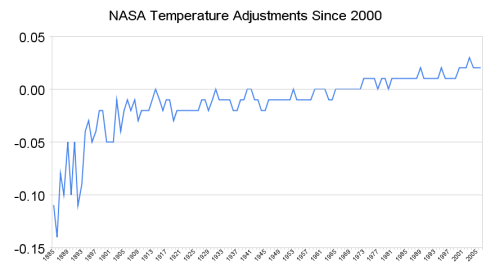This article is more than 1 year old
NASA's curious climate capers
Computer says: It's getting warmer
In 2007, while examining GISS data, McIntyre caught what turned out to be, of all things, a "Y2K" code error that forced a GISS to change the hottest year on US record to 1934. (Subsequent "improvements" have rectified this situation and 1934 reigns no more, but is tied with 1998.)
Dr Hansen had refused to release his adjustment code, but the Y2K incident caused him to relent. He provided a dump of undocumented, non-working FORTRAN code which Climate Audit coders, after much time and effort, eventually managed to get running.
It became apparent that Hansen's code that adjusted for missing data (FILNET) had arbitrarily adjusted the 20th Century temperature trend upwards several times by 0.1°C at regular intervals - with no explanation.
(GISS takes NOAA adjusted data and applies an "unadjustment" procedure; why they do not simply start with NOAA raw data remains a mystery. They then apply their own adjustments. GISS UHI adjustment is particularly controversial, since many cities are adjusted warmer, not cooler, as one would expect from urban heat island effect.)
And Steven Goddard reported here how the historical data has been altered since 2000.

Methods in the spotlight
Yes, GISS-adjusted historical data matches fairly well with that of the NOAA. But NOAA 20th century raw data trend is adjusted upwards by about 0.3°C. Missing data fill-in (FILNET) and Station history adjustment (SHAP) are both upward. But common sense tells us that the former should be near-neutral (interpolation) and the latter downward (poor station siting and urban creep having introduced often severe warming biases over the years).
In addition, NOAA's adjustment for Urban Heat Island (UHI) over the entire 20th century is an insignificant -0.06°C. Yet papers by McKitrick and Michaels [abstract - background] and by LaDochy et al [abstract] in late 2007 indicate that NASA and NOAA adjustment methods may exaggerate warming trends by a factor of two. (LaDochy estimates UHI trends are x2 during the day and x5 at night. If true, current UHI adjustment is too small.)
GISS makes unannounced, unexplained changes, and this practice is confusing and gets in the way of scholarship. GISS calibrates its data to 0.01°C. This implies a very high degree of accuracy and low margin of error. But their aggregate adjustments add up to tens of times greater than this scale. Therefore to provide data in hundredths of a degree is a clear case of misplaced precision.
Hansen's role as the director in charge of the evidence of climate change has also caused controversy. It was Hansen who gave the issue national prominence during the 1988 Senate hearings. Recently he has urged trials for "climate criminals" - energy executives who disagree with his hypothesis and policy prescription (for Hansen has both). Hansen traveled to England to testify for the defence of environmental activists who vandalized a coal power station.
Whatever their point of view, scientists' data, methods, and procedures should be properly archived and open to all. And as Dr. Hansen is, after all, a public servant in charge of a vitally important set of data, this imperative would seem to apply doubly. ®
